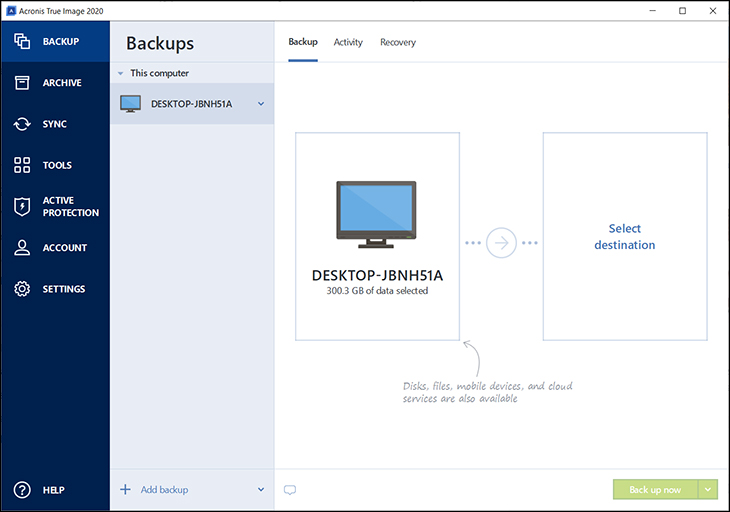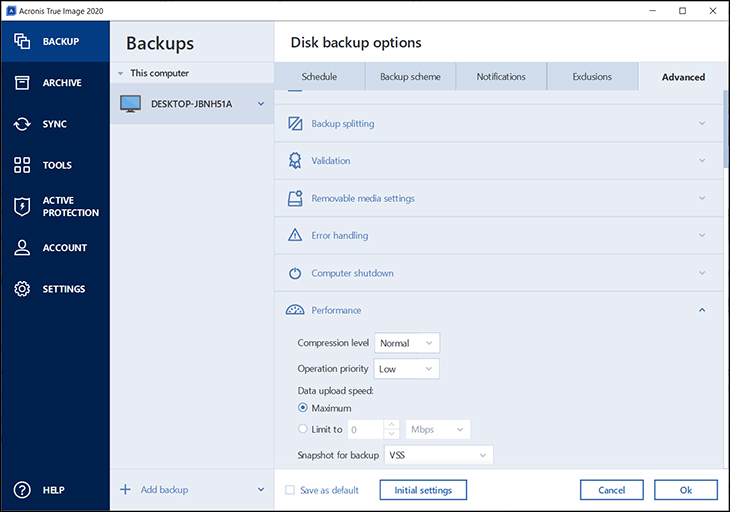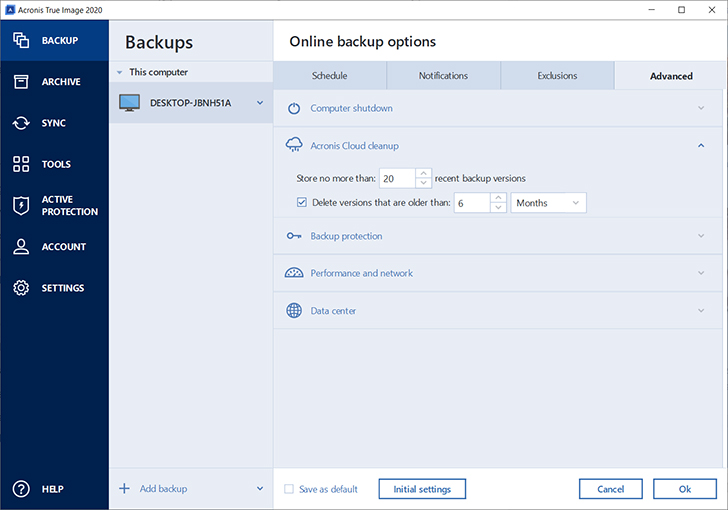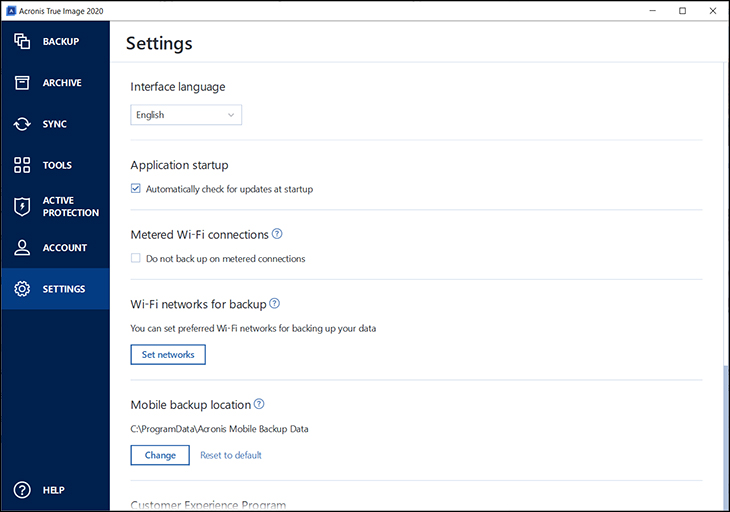
As you can see the User-Interface has not changed from the last generation. This is a good thing, as having to learn a new UI every year would get tedious to say the least. More importantly, instead of worrying about Icons or User Interface improvements this generation Acronis has instead focused in on a few key areas. The major ones are: auto replication, new backup features, and better anti-ransomware abilities. Also included is a fourth option – desktop push notification.
The least of these upgrades is push notifications. In previous generations you could easily hover over the Acronis TI icon in your desktop tray and get an idea of what it was doing. This generation it will give you not only a lot more details, but will use standard push notifications built into Windows 10 to notify you when things change. For example, if it pukes out and fails due to lack of storage space… it will let you know and get your attention. This is a nice improvement that actually makes the software easier to use. It however is no reason to upgrade. It is simply a nice little bonus feature included with all versions of Acronis TI 2020. In other words this is not a feature designed to entice you purchase a yearly cloud plan. It simply a nice little feature that Acronis feels every use should get.

The most interesting improvement is the under the hood improvements Acronis has done to its backup and compression algorithms. Acronis – for obvious reasons – is not explicitly stating what has and has not changed. Instead they vaguely talk about ‘improvements’ to the duplication detection and ‘faster than’ ever blurbs. In testing Acronis 2019 set to maximum compression took 97 minutes to back up 267GB into a 237GB .tib file. Using the same setting 2020 edition took 92 minutes to back up 300GB into a 225GB .tib file. So yes, it is indeed faster than it ever was before. Better still is while these improved 2020 edition .tib files are not backwards compatible with previous versions, previously created .tib files can be read by 2020. So, there is really no downside to upgrading from a compatibility point of view.
The other big feature is auto-replication. This arguably is actually more important than the newer and faster compression algorithms used. We say this, as when it comes to storing your backup images the old adage “one is none, and two is one” springs to mind. Too many people simply make a backup and keep it on the same rig – just on a different hard drive / storage device. This is suboptimal to say the least. While that will indeed get you out of a simple jam, like a dead OS drive, it will do jack squat against a nasty virus that nukes not only your ‘C’ drive but infects the hell out of everything and anything attached to said system. This is why we personally always backup to our NAS and an external USB drive that is only attached during backups.

Not everyone can do this. Whether it is because they do not own a Network Attached Storage device, or they simply are too busy (or simply forget) to plug in an external USB drive every once in a while and manually copy it, a surprisingly large number of people do not take this extra step. This is why Acronis includes Cloud Storage with their two ‘cloud’ tier options. Once again, the entry level cloud version comes with 250GB and the top of the line version comes with 1TB.
In previous versions it was not exactly seamless to backup to the cloud. It was more a case of ‘either / or’ in that you either created a backup to the system or backed up to the cloud. In other words, it was a decent way to upsell potential buyers on the yearly upgrade plan… but a lot of people went ‘meh’ and purchased the stand alone / one-time cost only option. This generation the software can do automatic replication to the cloud. It does this in a rather sensible manner as once the original / first backup in a backup scheme is complete (e.g. the ‘grandfather’ in a grandfather/father/son three gen backup configuration) it is automatically uploaded to your cloud account. Then when the next cycle in the backup cycle is started it simultaneously replicates it to the cloud as it stores it locally.

This of course does bring along a host of headaches. For example, what happens when you are not at home and your only Internet connection is your ‘phone plan’ which has a rather limited data allotment… and once you go over it you are charged out the butt per GB? Acronis has thought of that and allows you to configured it to not use metered connections.
Cool. What about unsecured public Wi-Fi… where anyone can attack you via man in the middle attacks and copy your entire system (complete with banking information… at the very least)? Acronis thought of that too and it will avoid public connections that are unsecure.
Not bad. Well what about the shear drain on your laptops’ battery as the CPU has to work overtime to push data to not only a local drive but the cloud at the same time? Yup. They thought of that too and you configure the power management feature to reduce load on the system (and thus on your battery).
The only issue with these new and powerful features is that these are all optional customization options. Options which default state is off. So, in this nifty new feature’s default configured state it will suck your battery dry. It will push it across any Internet connection you have. It will not care if the Internet connection is a buck a GB. It will use anything and anything it can. Thus, this is a great feature… but you can tell that is a ‘version 1.0’ feature. One that you will have to tweak a bit if you want to get the most of it. This actually is a point in the standalone’s favor… as you will never get a thousand dollar cell phone bill. Of course, as there is no cloud option you and only you are responsible for the data integrity and security of your secondary backup.

Moving on. In between these two major changes is a third. One that is important, but certainly not one we would base our decision on which plan to purchase over. That is the Anti-Ransomware feature. In this latest try, Acronis has patched the largest hole 2019 anti-ransomware feature had: service termination attack vectors. Basically, TI 2019 ransomware was not hardened against attacks on itself. Instead it was relying upon ‘security through obscurity’. This is never a good thing as a ransomware virus could (and did) seek it out and disable it before attacking the system. This low-level protection is a feature all actual anti-malware and anti-virus software solutions come with… and we honestly thought TI 2019 had this basic feature. Obviously it did not, but Acronis 2020 does. As such, this feature alone is worth the upgrade over 2019… if you are relying mainly upon MS + Acronis for your AV protection.
Also upgraded – in every edition – is the machine learning algorithms. For the past decade or longer relying solely upon previously discovered and quantified list of virus signatures has not worked all that well. Yes, such ‘old school’ methods of checking a file against a list of known virus definitions will catch most… but it does jack against new and freshly created/modified viri (or ‘viruses’ if you want to pedantic). Catching these threats before they are known threats is called heuristic learning and is based upon machine learning algorithms and a lot of math. No two AV virus vendors use the same algorithms. No vendor will share their code. Instead if you want to make an AV with it… you have to start from scratch. This is why Acronis is and will be behind the curve, however the latest 2020 edition promises to be faster and smarter than its predecessor. We still would not recommend relying solely upon it, but is better than nothing (and we consider Windows built in ‘Defender’ to be almost as bad as nothing). In other words, it will not replace Eset, Avira, or Kaspersky as our ‘go to’ options. Consider it a nice bonus. A bonus that is now more useable.
As you can see Acronis did not only focus in on up-selling their cloud software options but has made a pretty decent case for upgrading from 2019.











